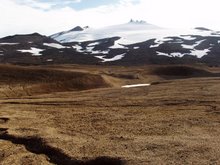Extensive deposits of rounded pumice clasts found in channels and along the margins of channels (over-bank deposits) to the west and south of the volcano, originating at glacier margins to the north-west, west and east. In some cases geomorphological evidence such as cataracts and boulder deposits point to unusually large flows over post-glacial lava surfaces.
Particularly thick (more than 5 metres high) deposits are found close to the ice margins, and overlying glacial ice-marginal landforms to the north and east of the volcano. It is as yet unclear if these are primary airfall deposits or flood deposits.
Geomorphological mapping, preliminary sedimentary investigations carried out since the summer of 2005 and points noted by Jóhannesson and others (2001) during tephrochronological studies indicate that there have in the past been at least three main flood routes associated with eruptions. Pumice left by tephra fall and jökulhlaup deposition during the last eruption is found in very thick deposits close to the northern and eastern contemporary glacial limits. As well as eruption-related jökulhlaups the presence of these thick, light-weight, unconsolidated deposits could have resulted in an extended period of rain-triggered reworking of material in lahars and damming of drainage routes by accumulations of erupted and flood-deposited material.
Jóhannesson, H., Flores, R. M. and Jónsson, J. 1981. A short account of the Holocene tephrochronology of the Snæfellsjökull central volcano, Western Iceland. Jökull, 31, 23-30.
skip to main |
skip to sidebar

Kate Taylor Smith, Postdoctoral researcher, University of Iceland, kate@raunvis.hi.is
Snæfellsjökull

Welcome
Hello and welcome to my Snæfellsjökull research page. Here you can find information about my Snæfellsjökull floods and hazards project and links to related information. Please feel very welcome to contact me about my research work at kate@raunvis.hi.is For more information about me and my other work please see my main research page.
Snæfellsjökull research information
- Aims (1)
- Background (1)
- Methodology (1)
- Preliminary results and interpretation (1)
- Related publications (1)
Snæfellsjökull links
Thanks
.. go to my mentors at the University of Iceland, Guðrún Larsen and Hreggviður Norðdahl and volunteer field assistants on this project, Claire Robertson, Ross Perrin, Nicholas Cutler, and Ruth Walker.